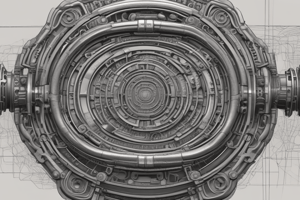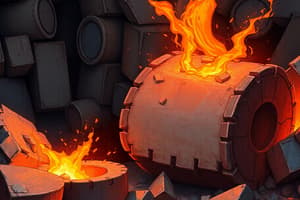Podcast
Questions and Answers
Which element, when present in cast iron above 0.005%, is likely to promote hydrogen pinholes?
Which element, when present in cast iron above 0.005%, is likely to promote hydrogen pinholes?
- Bismuth
- Arsenic
- Aluminium (correct)
- Barium
What is the effect of Antimony in cast iron at levels up to 0.02%?
What is the effect of Antimony in cast iron at levels up to 0.02%?
- Reduces dross formation
- Improves nodularity
- Promotes pearlite and carbide (correct)
- Inhibits pearlite formation
Which of the following elements improves nodular graphite shape in cast iron?
Which of the following elements improves nodular graphite shape in cast iron?
- Bismuth (correct)
- Aluminium
- Aluminium
- Barium
At what level can Barium improve graphite nucleation in cast iron?
At what level can Barium improve graphite nucleation in cast iron?
Which element is detrimental to nodular graphite above approximately 0.08%?
Which element is detrimental to nodular graphite above approximately 0.08%?
What can help neutralize the effects of Aluminium in cast iron?
What can help neutralize the effects of Aluminium in cast iron?
Which element increases nodule number in ductile irons when above a certain level?
Which element increases nodule number in ductile irons when above a certain level?
Which element is noted to reduce chilling tendency and promote graphite formation?
Which element is noted to reduce chilling tendency and promote graphite formation?
What is the effect of lead at levels above 0.004% in cast irons?
What is the effect of lead at levels above 0.004% in cast irons?
Which element is known to neutralize sulphur in ductile irons?
Which element is known to neutralize sulphur in ductile irons?
What effect does magnesium have in ductile irons?
What effect does magnesium have in ductile irons?
At what percentage does manganese form segregates in ductile irons?
At what percentage does manganese form segregates in ductile irons?
What is the function of molybdenum in cast irons?
What is the function of molybdenum in cast irons?
Which substance is associated with causing degenerated nodular graphite forms?
Which substance is associated with causing degenerated nodular graphite forms?
What is the role of rare earth elements (cerium) in ductile irons?
What is the role of rare earth elements (cerium) in ductile irons?
What level of magnesium typically affects ductile irons?
What level of magnesium typically affects ductile irons?
What effect does boron have on ductile irons?
What effect does boron have on ductile irons?
How does calcium impact graphite in iron alloys?
How does calcium impact graphite in iron alloys?
What is the effect of chromium at levels above 0.5% in ductile irons?
What is the effect of chromium at levels above 0.5% in ductile irons?
What negative effect can copper have in ductile iron?
What negative effect can copper have in ductile iron?
What role does cerium play in the treatment of ductile irons?
What role does cerium play in the treatment of ductile irons?
Hydrogen in humid conditions can promote which undesirable effect?
Hydrogen in humid conditions can promote which undesirable effect?
At what level does excessive nodule count start causing shrinkage problems?
At what level does excessive nodule count start causing shrinkage problems?
What happens to the strength of alloys if phosphorus levels rise significantly?
What happens to the strength of alloys if phosphorus levels rise significantly?
What effect does phosphorus have on ductile irons at levels above 0.05 %?
What effect does phosphorus have on ductile irons at levels above 0.05 %?
What is the maximum acceptable level of sulfur in ductile irons?
What is the maximum acceptable level of sulfur in ductile irons?
Which element increases strength but may cause fissure defects at high levels?
Which element increases strength but may cause fissure defects at high levels?
At what level can silicon be damaging to the structure and properties of iron?
At what level can silicon be damaging to the structure and properties of iron?
What effect does strontium have on graphite formation in grey and ductile irons?
What effect does strontium have on graphite formation in grey and ductile irons?
What is a consequence of adding too much tin to ductile irons?
What is a consequence of adding too much tin to ductile irons?
Which of the following elements is known for causing undesirable forms of graphite?
Which of the following elements is known for causing undesirable forms of graphite?
What is the role of nitrogen in iron when added in high levels?
What is the role of nitrogen in iron when added in high levels?
Flashcards
Aluminum effect in cast iron
Aluminum effect in cast iron
Aluminum in cast iron, above 0.005%, promotes hydrogen pinholes in thin areas, neutralizes nitrogen, promotes dross formation, and is detrimental to nodular graphite above approximately 0.08%.
Antimony's role in cast iron
Antimony's role in cast iron
Antimony, up to 0.02%, is a strong pearlite and carbide promoter; it inhibits nodularity in cast irons, in absence of rare earths.
Arsenic effect
Arsenic effect
Arsenic, up to 0.05%, in cast irons, improves the shape of nodular graphite.
Barium's impact
Barium's impact
Signup and view all the flashcards
Bismuth role
Bismuth role
Signup and view all the flashcards
Aluminum sources
Aluminum sources
Signup and view all the flashcards
Harmful elements in cast iron
Harmful elements in cast iron
Signup and view all the flashcards
Beneficial minor elements
Beneficial minor elements
Signup and view all the flashcards
Boron's effect on cast iron
Boron's effect on cast iron
Signup and view all the flashcards
Calcium's role in cast iron
Calcium's role in cast iron
Signup and view all the flashcards
Cerium's effect on ductile iron
Cerium's effect on ductile iron
Signup and view all the flashcards
Chromium's impact on cast iron
Chromium's impact on cast iron
Signup and view all the flashcards
Cobalt's effect on cast iron
Cobalt's effect on cast iron
Signup and view all the flashcards
Copper's role in cast iron
Copper's role in cast iron
Signup and view all the flashcards
Hydrogen's effect on cast iron
Hydrogen's effect on cast iron
Signup and view all the flashcards
Lead's effect on grey iron
Lead's effect on grey iron
Signup and view all the flashcards
Lead's effect on ductile iron
Lead's effect on ductile iron
Signup and view all the flashcards
Magnesium's role in ductile iron
Magnesium's role in ductile iron
Signup and view all the flashcards
Manganese's effect on cast iron
Manganese's effect on cast iron
Signup and view all the flashcards
Molybdenum's impact on cast iron
Molybdenum's impact on cast iron
Signup and view all the flashcards
What is the impact of high sulfur content on cast iron properties?
What is the impact of high sulfur content on cast iron properties?
Signup and view all the flashcards
Why is magnesium used in ductile iron?
Why is magnesium used in ductile iron?
Signup and view all the flashcards
What is the effect of Nickel in cast iron?
What is the effect of Nickel in cast iron?
Signup and view all the flashcards
How does Nitrogen affect cast iron?
How does Nitrogen affect cast iron?
Signup and view all the flashcards
What is the impact of Phosphorus?
What is the impact of Phosphorus?
Signup and view all the flashcards
How does Silicon affect cast iron?
How does Silicon affect cast iron?
Signup and view all the flashcards
What is the role of Sulphur in cast iron?
What is the role of Sulphur in cast iron?
Signup and view all the flashcards
What is the effect of Strontium in cast iron?
What is the effect of Strontium in cast iron?
Signup and view all the flashcards
What is the impact of Tellurium?
What is the impact of Tellurium?
Signup and view all the flashcards
How does Tin affect cast iron?
How does Tin affect cast iron?
Signup and view all the flashcards
Study Notes
Effects of Minor and Trace Elements in Cast Iron
- Small amounts of various elements significantly impact cast iron's structure and properties.
- Some elements are intentionally added, while others are impurities from raw materials.
- Some elements are beneficial, especially in gray iron, while others are detrimental.
- Chromium is a major alloying element not included in the table.
Element Effects
- Aluminum (Al): Can promote hydrogen pinholes in light sections above 0.005% Al. Neutralizes nitrogen and can promote dross formation. Detrimental to nodular graphite above about 0.08%, but can be neutralized by cerium. Strong graphite stabilizer.
- Antimony (Sb): Strong pearlite and carbide promoter. Inhibits nodularity in the absence of rare earth metals.
- Arsenic (As): Strong pearlite and carbide promoter.
- Barium (Ba): Improves nodular graphite shape. Improves graphite nucleation and reduces fading. Reduces chilling tendency.
- Bismuth (Bi): Increases nodule number in ductile irons. Excessive nodules can cause shrinkage problems. Promotes chill and undesirable forms of graphite.
- Boron (B): Promotes ferrite above 5 ppm, carbides above 10 ppm. Improves annealing of malleable irons.
- Calcium (Ca): Improves graphite nucleation. Reduces chilling tendency and promotes graphite.
- Cerium (Ce): Improves the spheroidization of graphite nodules. Carbide stabilizing due to segregation.
- Chromium (Cr): Not typically used in grey irons, but can suppress deleterious elements in ductile irons and improve spheroidization of graphite. Stabilizes carbides.
- Cobalt (Co): Forms carbide segregates in ductile irons above 0.05%. Promotes pearlite and increases strength.
- Copper (Cu): No significant effects in cast irons, but may promote pearlite.
- Hydrogen (H): Produces sub-surface pinholes. Has a mild chill-promoting action. Promotes "inverse chill." Promotes coarse graphite. Promotes dross formation.
- Lead (Pb): Causes spiky, undesirable graphite structures that reduce strength. Promotes pearlite and carbides.
- Magnesium (Mg): Causes degenerated nodular graphite forms. Its effects on graphite in ductile irons are neutralized by rare earth metals. Promotes nodular graphite in ductile irons.
- Manganese (Mn): Promotes pearlite formation. Helps neutralize sulfur. Forms carbides. Can promote gas holes.
- Molybdenum (Mo): Mild pearlite promoter.
- Nickel (Ni): Increases strength. Can promote shrinkage and carbides.
- Nitrogen (N): Increases strength, but high levels can lead to fissure defects.
- Phosphorus (P): Increases fluidity and promotes graphitization. Reduces chill, and stabilizes ferrite. Damaging to structure and properties unless balanced by Manganese. Improves grey irons response to most inoculants. Increases magnesium needs in ductile irons.
- Silicon (Si): Promotes graphitization, reduces chill, and stabilizes ferrite. Improves castability.
- Sulfur (S): Very damaging to structure and properties. Improves nucleation in grey and ductile irons.
- Strontium (Sr): Improves graphite nucleation, reduces chilling for grey and ductile irons.
- Tellurium (Te): Strongly promotes carbides, leading to undesirable graphite forms.
- Tin (Sn): Strongly promotes pearlite and increases strength. Embrittles ductile irons above 0.08%.
- Titanium (Ti): Neutralizes nitrogen in grey irons, promotes pinholing due to aluminum, promotes undercooled graphite, and suppresses nodular graphite in CG-irons.
- Tungsten (W): Mild pearlite promoter.
- Vanadium (V): Promotes chill formation, refines flake graphite, and markedly increases strength.
Studying That Suits You
Use AI to generate personalized quizzes and flashcards to suit your learning preferences.





